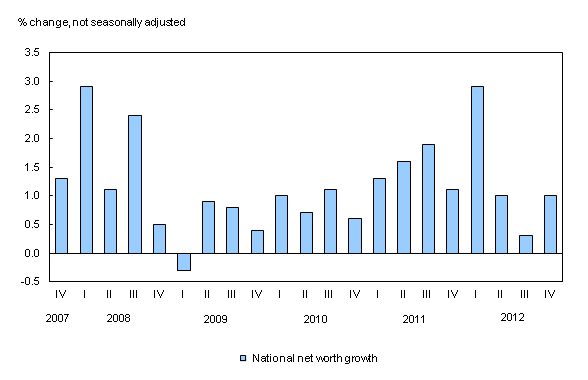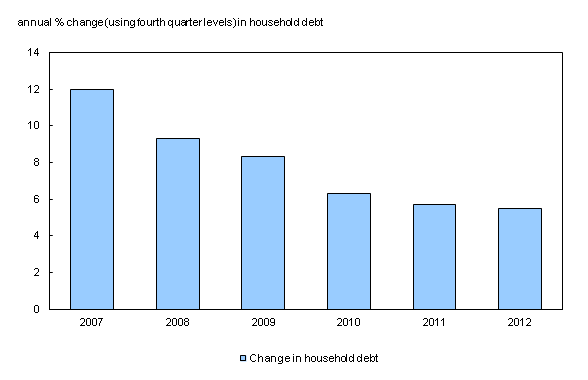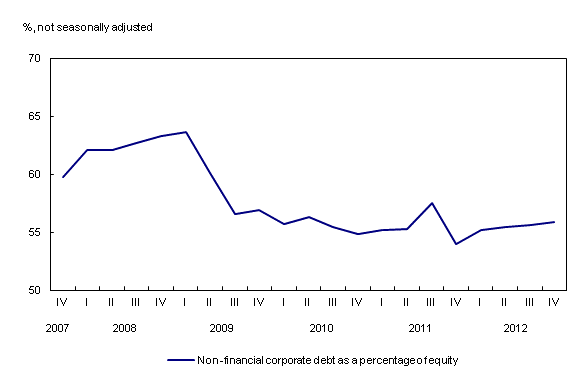National balance sheet and financial flow accounts, fourth quarter 2012
Archived Content
Information identified as archived is provided for reference, research or recordkeeping purposes. It is not subject to the Government of Canada Web Standards and has not been altered or updated since it was archived. Please "contact us" to request a format other than those available.
Released: 2013-03-15
National net worth and wealth
National net worth increased to $6.9 trillion in the fourth quarter, up 1.0% from the third quarter of 2012 to reach $195,900 on a per capita basis. Higher prices for many assets led the advance, while national saving accounted for 29% of the increase in national net worth. National saving was again led by corporate sector saving.
The decrease in Canada's net foreign indebtedness also contributed to the gains in national net worth. Lower net foreign debt was largely a result of lower inflows of funds from abroad and the positive effect of a lower Canadian dollar on foreign currency denominated international assets.
National wealth advanced $62.5 billion to reach $7.2 trillion at the end of the fourth quarter. This represented a gain of 0.9%, largely reflecting increases in the value of residential real estate.
Sector analysis
Household sector
Household net worth advanced 1.4% in the fourth quarter, led by gains in the values of equity holdings (including mutual funds) and pension assets. However, these assets grew at a slower pace than in the previous quarter, largely reflecting weaker Canadian stock markets. The Standard and Poor's / Toronto Stock Exchange composite index rose 0.9% in the quarter, compared with a 6.2% increase the previous quarter. The value of household real estate increased by 0.9% in the fourth quarter, reflecting continued investment in housing. On a per capita basis, household net worth rose to $199,700 in the fourth quarter, from $197,400 in the previous quarter.
Funds raised by households (consumer credit, loans and mortgages) were $14.7 billion in the fourth quarter. Mortgage borrowing led the demand for funds, at $11 billion in the quarter. Mortgage debt reached $1.1 trillion and consumer credit debt stood at $477 billion by quarter-end.
Leverage was largely unchanged in the quarter. Owner's equity as a percentage of real estate remained just under 69%, and household credit market debt to disposable income remained at almost 165% in the fourth quarter. On an annual basis, the level of debt increased by 5.5% in 2012.
Government
The overall government sector borrowing was down relative to the first three quarters of 2012, amounting to $8.5 billion in the fourth quarter. Nevertheless, government net debt (expressed at book value) rose to $913.4 billion in the fourth quarter, compared with $896.3 billion in the third quarter. Part of this increase was related to higher values for foreign currency denominated debt, reflecting a lower Canadian dollar.
The ratio of total government net debt to gross domestic product continued to trend upward, increasing to 50.3% in the fourth quarter from 49.6% in the third quarter.
Non-financial corporations
The demand for funds on financial markets by non-financial corporations was lower in the fourth quarter. Nevertheless, funds were raised through both borrowing and share issuances. On a book value basis, debt-to-equity was unchanged by quarter-end, with 56 cents of credit market debt for every dollar of equity. The trend since early 2009 has been a general decrease in non-financial corporate debt-to-equity.
The corporate sector remained a net lender to the rest of the economy, led by financial corporations. This mainly reflected continued strong internally-generated funds.
Institutional investors
Financial institutions saw their financial assets increase by $76.5 billion to reach $9.3 trillion, a 0.8% rise over the previous quarter, through both transactions and revaluations. Increases in loan assets were led by deposit accepting intermediaries and increases in share assets by mutual funds.
Funds raised on financial markets and credit market debt
Total funds raised by domestic non-financial sectors on financial markets amounted to $34.5 billion in the fourth quarter, with households accounting for a little over half of private sector demand for funds. Overall government demand for funds decreased in the quarter, mainly in the federal government sector.
Credit market debt (consumer credit, mortgages, loans, short-term paper and bonds) of domestic non-financial sectors totaled $4.0 trillion at the end of the fourth quarter, up 0.9% from the previous quarter. Bonds and mortgage debt accounted for the largest share of total non-financial sector credit market debt outstanding.
Note to readers
This release is a combined analysis of the National balance sheet accounts and Financial flow accounts. The National balance sheet accounts comprise the balance sheets of all sectors and sub-sectors of the economy. The main sectors are households, non-profit institutions serving households, financial corporations, non-financial corporations, government, and non-residents. They cover all national non-financial assets and financial asset-liability claims outstanding in all sectors.
The Financial flow accounts (FFA) measure net lending or borrowing by examining financial transactions in the economy by sector. The FFA arrive at a measure of net financial investment which is the difference between transactions in financial assets and liabilities (for example, net purchases of securities less net issuance of securities). The FFA also provide the link between financial and non-financial activity in the economy which ties estimates of saving and non-financial capital acquisition (for example, investment in new housing) with the underlying financial transactions.
Definitions concerning financial indicators can be found in Financial indicators from the National Balance Sheet Accounts.
The National economic accounts module, accessible from the Browse by key resource module of our website, features an up-to-date portrait of national and provincial economies and their structure.
Links to other releases from the national accounts can be found in the fourth quarter 2012 issue of Canadian Economic Accounts Quarterly Review, Vol. 11, no. 4 (Catalogue number13-010-X). This publication is now available from the Browse by key resource module of our website under Publications. Revised National balance sheet and financial flow accounts for the first, second and third quarters of 2012 have been released, along with those for the fourth quarter of 2012. These data incorporate new and revised source data and updated data.
Data on National balance sheet and financial flow accounts for the first quarter will be released on June 20.
Contact information
For more information, or to enquire about the concepts, methods or data quality of this release, contact us (toll-free 1-800-263-1136; infostats@statcan.gc.ca) or Media Relations (613-951-4636; statcan.mediahotline-ligneinfomedias.statcan@canada.ca).
- Date modified:




